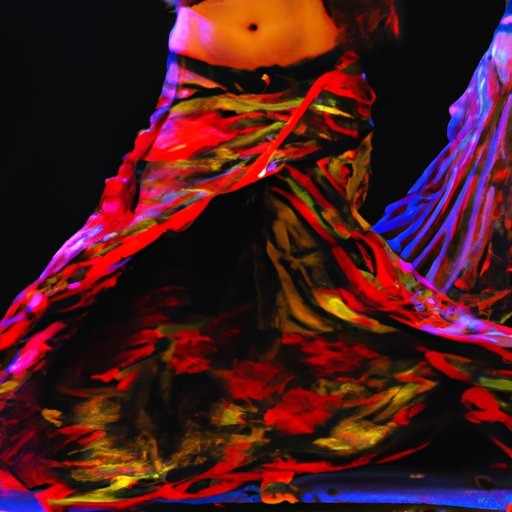Introduction
Belly dancing is a form of dance that has been practiced for centuries around the world. It often involves intricate movements of the torso and hips, set to an accompaniment of music and sometimes props such as veils or swords. Although it is most closely associated with the Middle East, it has evolved over time to incorporate elements from many different cultures. In this article, we will explore the historical origins of belly dancing, its cultural influences, traditional costumes, music and rhythms, and different styles found around the world.

Historical Origins of Belly Dancing
The exact origins of belly dancing are unknown, but it is thought to date back to ancient times in the Middle East. According to some scholars, the earliest evidence of belly dancing can be found in tomb paintings in Egypt dating back to 1400 BCE. These paintings depict women performing what appears to be a form of belly dance, suggesting that it was already an established practice at that time.
The development of belly dancing in Egypt and Turkey is also documented in early writings. For example, the Greek historian Herodotus wrote about “a kind of dance” in which women moved their bodies in a seductive way during religious ceremonies in Egypt. By the 15th century, it had spread to Turkey where it was performed by female dancers in the Ottoman court.
Exploring the Cultural Influences on Belly Dancing
The evolution of belly dancing has been shaped by the various cultures it has encountered over the centuries. As it spread from the Middle East to North Africa and Europe, it began to incorporate local music and dance forms. This created a rich tapestry of styles that reflect the diverse cultural heritage of the region.
For example, the Middle Eastern style of belly dancing incorporates elements from Arabic, Turkish, and Persian cultures, while North African styles draw on influences from Morocco, Algeria, and Tunisia. Similarly, European styles often incorporate elements from Spanish, French, and Italian traditions.

A Look at the Traditional Costumes Associated with Belly Dancing
Traditional belly dancing costumes vary from region to region, but they typically feature bright colors, elaborate patterns, and rich fabrics. They are often adorned with coins, beads, and other embellishments to add texture and movement to the dancer’s performance. Commonly used materials include silk, satin, velvet, and chiffon.
Costumes can also vary depending on the type of dance being performed. For instance, styles from the Middle East tend to feature long, flowing skirts and veils, while those from North Africa and Europe often include tight-fitting tops and trousers. The choice of costume is often dependent on the region, culture, and occasion.
The Music and Rhythms of Belly Dancing
Music plays a key role in belly dancing, and there are many types of music that are commonly used. These range from traditional Arabic music to modern pop songs, and the choice of music is often determined by the type of dance being performed. Different regions also have their own distinct musical styles, such as the Egyptian mahraganat genre.
Rhythms are also an important part of belly dancing. Commonly used rhythms include the masmoudi, sa’idi, maqsoum, and baladi. These rhythms help to create the flow of the dance and give it structure. They are often combined with traditional instruments such as tabla drums, qanun zithers, and oud lutes.

Different Styles of Belly Dancing Around the World
Belly dancing is practiced in many different countries around the world, and each region has its own unique style. Popular styles from the Middle East include the classical Egyptian Raqs Sharqi and the Lebanese Dabke. Variations can also be found in North Africa, such as the Algerian Debke, and in Europe, such as the Spanish Flamenco.
In recent years, there has been an increase in the number of fusions between belly dancing and other genres of dance. This has led to the emergence of new styles such as fusion belly dance and tribal fusion belly dance, which combine elements from various dance forms to create something completely unique.
Modern Innovations in Belly Dancing
As belly dancing has become more popular in recent decades, modern innovations have been incorporated into the art form. Contemporary music and dance forms have been added to the mix, creating a vibrant and exciting new style of belly dancing. Some dancers have even taken the traditional moves and adapted them to fit different genres of music, such as hip-hop and jazz.
In addition, some performers have begun to use props such as swords and candles in their performances, adding an extra layer of visual interest. This has opened up new possibilities for creative expression, allowing dancers to explore different ways of expressing themselves through their art.
Conclusion
Belly dancing is a form of dance that has evolved over time to incorporate elements from many different cultures. Its historical origins can be traced back to the Middle East, but it has since spread around the world and been influenced by local music and dance forms. Traditional costumes, music, and rhythms all play an important role in the art form, and there are now many different styles of belly dancing to be found globally.
Modern innovations have also played a role in the evolution of belly dancing, with contemporary music and dance forms being incorporated into the mix. This has opened up new possibilities for creative expression, allowing dancers to explore different ways of expressing themselves through their art.
(Note: Is this article not meeting your expectations? Do you have knowledge or insights to share? Unlock new opportunities and expand your reach by joining our authors team. Click Registration to join us and share your expertise with our readers.)
